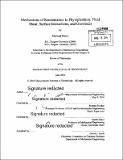Mechanisms of reorientation in phytoplankton : fluid shear, surface interactions, and gravitaxis
Author(s)
Barry, Michael, Ph. D. Massachusetts Institute of Technology
DownloadFull printable version (16.12Mb)
Other Contributors
Massachusetts Institute of Technology. Department of Mechanical Engineering.
Advisor
Roman Stocker.
Terms of use
Metadata
Show full item recordAbstract
Phytoplankton are a vital part of the ecosystem in oceans and lakes, where they form the base of the food chain and have major global impacts, for example producing 50% of the planet's oxygen. Phytoplankton can also serve as a clean source of biofuel and, as concerns over both climate and energy grow, it is increasingly important to understand these organisms in both the natural and engineered systems they inhabit. This thesis focuses on the role of fluid flow, ubiquitous in phytoplankton habitats, and on the motility, spatial distribution, and interaction with surfaces of these important cells. Using accurately controlled shear flows in microfluidic devices, we show that the interaction of flow and motility can produce strong spatial heterogeneity in the distribution of phytoplankton. Four different species were tested over a broad range of shear rates, revealing that the effects of flow are species-specific. Some species display a response that can be accounted for solely by the effect of the shear-induced hydrodynamic torque on the swimming cells, resulting in characteristic Jeffery orbits and the emergent property of an effective aspect ratio. In contrast, results for other species are inconsistent with this picture and suggest an active, behavioral response to fluid shear, which allows cells to move towards low-shear regions. A second set of microfluidic experiments was devoted to understanding how two species of motile phytoplankton interact with solid surfaces, a precursor to the widespread problem of biofouling. Two cases were examined: that of cells with no bias in their swimming direction toward a surface, and that of cells biased to swim vertically and thus, in these experiments, towards the solid surface. Both conventional imaging and digital holographic microscopy were used to track cells, in two and three dimensions, respectively. Results revealed that the presence of a surface can affect cell distributions many cell diameters away from that surface, with the actual distance depending on the noise in the cell orientation and on the propulsion kinematics. Observations suggest that a simplified boundary condition to capture the cell-surface interaction consists of a specular reflection modulated by an effective rotational diffusivity based on helical swimming properties. Finally, a bias towards vertical swimming, common to many motile phytoplankton, had negligible effects on the immediate surface interactions. A third set of experiments probed the dynamics of one species of bottom-heavy, gravitactic phytoplankton, which use gravity as a physical cue to perform vertical migration in the ocean. Experiments were aimed at understanding swimming stability or how strongly the organisms tended to swim upward. A microscale experimental device Was constructed to allow a sudden change in the direction of gravity for swimming phytoplankton by flipping an observation chamber 180*. Time-lapse imaging was used to quantify the evolving probability density functions of swimming orientation throughout the phytoplankton population and interpreted in the context of a classic Fokker-Planck model of phytoplankton. The strength of gravitactic behavior was quantified through three different methods that return consistent results.
Description
Thesis: Ph. D., Massachusetts Institute of Technology, Department of Mechanical Engineering, 2014. Cataloged from PDF version of thesis. Includes bibliographical references (pages 123-132).
Date issued
2014Department
Massachusetts Institute of Technology. Department of Mechanical EngineeringPublisher
Massachusetts Institute of Technology
Keywords
Mechanical Engineering.